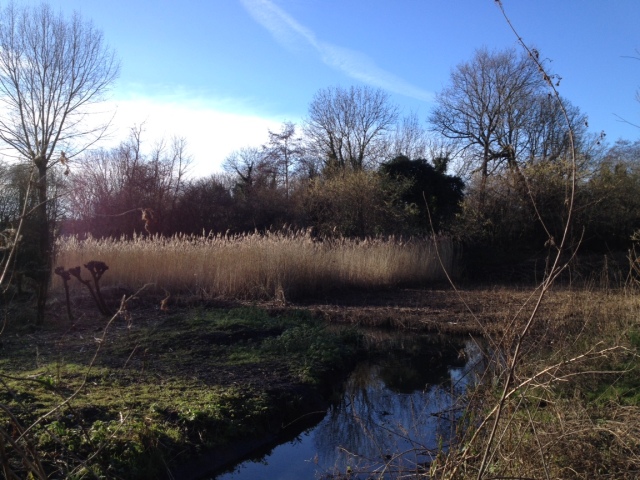I saw kingfishers along the river Crane three times this year. Each time I thought I’d burst. It’s amazing they’re thriving, given that the river has suffered four big ‘pollution incidents’ in the last four years.*
The first glimpse of ice blue came on a crisp bright day early January, whirring over the reed beds on Crane Park island, up by the Shot Tower. Unbelievable brilliance, like some CGI effect from a sci-fi movie.

Reed bed on Crane Park island, January 2015
The second flash came on a dull September day, where the Duke of Northumberland’s River (which is fed by the Crane) runs under the railway en route to The Stoop. The bird doesn’t seem to need the sun for its iridescence.

Duke of Northumberland’s River flows under the London-Reading railway line
And lastly on Christmas day, not far from Meadway, we watched a kingfisher hunting from a slender branch of a sycamore, overhanging the shallow waters. Not just an electric flash this time, but a thrilling sequence of dives, returns and keen observation of the water. A few yards away, a little grebe dipped its slick head and also dived repeatedly. There is food to be had in this strange unwintery winter.

Little grebe on the Mill Road section of the River Crane. Photo: Belinda Price

Honda
The rough land along the Crane periodically disgorges some intriguing detritus, but you can also see some impressive work going on to improve the health of the river and to increase the biodiversity along its banks, thanks to the Crane Valley Partnership and FORCE . Early in the year, the trees along the banks were thinned to allow more light to reach the water. More recently, long sections of the wooden planks reinforcing the southern bank have been removed and in places the bank itself has been broken up to create marginal wetland habitats.
It will be fascinating to see how the unprotected banks disintegrate and to track their gradual colonisation by plants and animals. Another reason to be excited about the year ahead. George Monbiot has been making lucid arguments in favour of ‘rewilding’ rivers for the Guardian:
Rivers that have been dredged and canalised to protect farmland rush the water instead into the nearest town. Engineering works of this kind were removed a few years ago from the river Liza in Ennerdale. It was allowed to braid, meander and accumulate logs and stones.
When the last great storm hit Cumbria, in 2009, the Liza remained clear and fordable the following day, while other rivers roared into furious spate.
His arguments are pragmatic and anthropocentric, as they need to be if they are to gain traction amongst the policy makers. But for the rest of us the glimpse of a kingfisher makes an argument as powerful and eloquent as any words.
*The worst happened in October 2011, the discharge of raw sewage by Thames Water (due to a ‘mechanical fault’) wiped out all fish life ‘including barbel, bleak, bream, carp, chub, dace, eels, gudgeon, minnows, perch, pike, roach and sticklebacks.’ Two years later, the fracture of an underground pipe resulted in concentrated sewage sludge killing ‘much of the newly- established fish life … hundreds of chub, dace, gudgeon, minnows, roach and sticklebacks between 1-2 inches long.’ Read ‘a personal record of pollution on the Crane, compiled by a local fisherman from observations of the lower Crane near Meadway and the lower DNR (Dukes River) over 27 years between 1986 and 2013’.





Interesting- I haven’t seen a king fisher for months and I walk in Crane park nearly everyday. But it’s a special day when I do see one and I’m always on the lookout. I used to see them frequently.
LikeLike
Hello Kate – it does make the day very special doesn’t it? We were amazed by the Christmas Day sighting – I hadn’t seen a kingfisher anywhere near the Mill Road section before, and only ever caught glimpses, so it was fantastic to watch one for some time, and really extraordinary because there were so many families and dogs around.
LikeLike
Great pictures!
LikeLike
Thanks Catherine
LikeLike